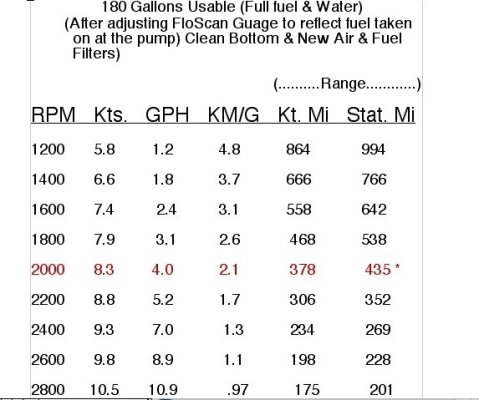nomadwilly wrote:
There are advantages to*30 to 40 feet of chain but any more and the advantages*aren't even close to the disadvantages of packin all that weight on the boat..... What I*was refering to*in my post was the half of the anchor rode that is*attached to*the boat rather than the half that is attached to the*anchor.
On the few occasions we've taken the all-chain rode off our boat to install a new windlass or do other work in the chain locker, the difference in the boat's trim and the waterline at the bow was so negligible it was virtually unnoticeable.* But this is a 27,000 pound boat.* A few hundred pounds in the bow makes virtually no difference to it.* In fact the more weight you put in a trawler the better it rides

When you say the half of the rode that is attached to the boat vs the half that is attached to the anchor it demonstrates to me that perhaps you don't understand that the ENTIRE rode that is deployed is playing a role in how well your boat stays put, not just the few feet of chain near the anchor.* And this is the advantage of all-chain, because that heavy "half" attached to the boat plays a major role in how well the anchor sets and stays set.* I've boated on a couple of occasions with friends who have combination rodes.* A couple are sailboaters, one is a powerboater.* And when the wind comes up some, their rode--- out at least to a 7 to 1 ratio--- is more or less straight out.* Which means it's starting to lift that few feet of chain attached to the anchor and raising the angle of pull.* At the same time in the same place in the same wind, our all-chain is angled slightly forward, with a 5 to 1 scope.* Which means all that weight you complain about is doing a geat job of keeping the pull on the anchor low.
If you have a light-weight boat or a planing boat or a boat that's very sensitive to trim (like many sailboats), the weight of all-chain is a definite consideration and in those cases going with a combination rode makes more sense.* But if one's boat can carry it--- which most true (aka heavy) trawlers over 30 feet or so should be able to do--- all-chain should pose no trim issues at all.* I'm talking about a couple hundred feet of chain.* Sure, 500 feet of all-chsin on a 36' boat is going to be overweight and overkill.* We have a 200' combination rode for our stern anchor that can be shackled to our main all-chain rode if we need a lot of rode out, although we haven't had to do this yet.
As to FF's comment about how slow all-chain is to retrieve, that totally depends on the windlass.* Our original windlass was so slow you could probably make new chain as fast as it brought in the old chain.* It finally broke and we put a new Lofrans Tigres on our boat the other year.* This thing brings the chain in so fast it's a bit scary.* And it's a LOT faster than it takes our friends with the combination rodes to get their anchors up, plus we don't have to mess with winding rode around capstan drums or feeding uncooperative line down into the anchor locker.* While researching the type of windlass we wanted to get I read a comment from a charter schooner skipper in the Carribbean* who said thta in addtion to using their Tigres to handle the anchor, they use it to hoist their headsails because it's so fast.* So all-chain or combination is not what determines how fast it comes up, the windlass (or lack of one) does.
We have a very powerful washdown system thanks to a previous owner so the chain goes into the locker clean.* Never had to scrub it with anything, the mud comes right off in the blast of water.* I've noticed that mud and muck come off a chain a lot faster and easier than it comes off of-- and out of-- a nylon rode.* We have friends with stinky anchor lockers--- in all cases it's with a combination rode.
So based on our ten year's experience with all-chain rode, the advice of very experienced acquaintances who've used both combination and all-chain over the years, and what I've observed of people using combination rodes, I would never use a combination rode on our particular type of boat.* But for us weight is not a penalty, and the sometimes tight anchorages we frequent make it more convenient to use a 5 to 1 scope instead of the longer scope needed with a combination rode.
But that's not to say that all-chain is the best answer for someone else's boat.* Like everything to do with anchoring, it comes down to boat type, bottom type, the type of weather one has to deal with, and a kabillion other variables, all of which have to be taken into account.

